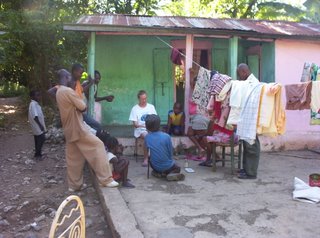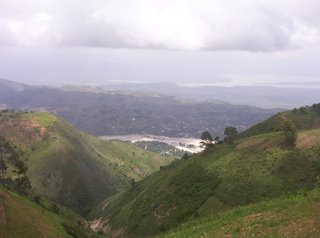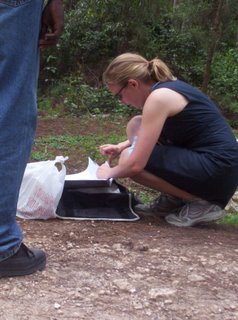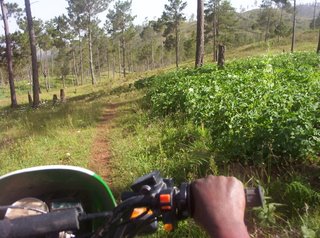Thursday, 13 July 2006, Fond Verrettes


I decided to get a few points by myself before breakfast so I went to the road above the house on the mountain called Bois Neuf. I attempted to climb a rock to see what was on top—barren or with trees, it was important because my 2000 satellite image indicated barren but from the road it looked to be trees, and this was on the mountain that they’ve reforested starting around 1998 which would mean the remotely sensed data is telling the same “story” as the people in the area —and ended up falling onto the road. I was quite scared and shaken up, though I wasn’t sure why. I was afraid I’d broken the GPS; all the batteries spilled out. I’d scraped up my palms and legs but then I noticed my ankle was swelling up in a huge way and I couldn’t put much weight on it. I hoped it wasn’t broken. I gathered up my stuff and found 3 of the 4 batteries. I had to sit at the edge of the road, even though it wasn’t really a good place to sit, since I felt I was going to black out. I tried to find the fourth battery and finally I found it and hobbled to pick it up before an SUV came by. It felt like a small victory to find all the batteries!
I slowly made my way down the gravel (steep!) path to the Bois Neuf path below and then to the house. It was easier to walk on the flat path. I really needed to lie down and elevate my leg, which they let me do, but they wanted to put tepid water on my ankle and I wanted ice. They finally gave me a small bit of ice—not sure it was enough to do anything—and agreed to let me elevate my foot. I asked for a heavy blanket since I was quite cold. It felt good to lie down and elevate my leg. I was frustrated, though, that they were more concerned about my scraped-up hands than my leg and were washing my scrapes with saltwater, which was fine but they were minor scrapes. I wanted ice for my ankle!
Ginette said she’d called someone who “pulls legs” to come check me out. She said the swelling was blood and needed tepid water to get rid of it, and that I’d displaced the veins in my ankle. Since she’s a nurse, I didn’t argue. They were busy gathering and buying the things necessary for the healing.
The healer had me get out of bed and sit on the porch with my feet on the ground. A small crown of about 15 people gathered to watch. The healer crossed himself and murmured some words and drew a cross on the ground with charcoal ashes. He put my foot on the cross and pressed it down, then took a corn cob (kernels eaten already) and drew a cross several times on my leg and food while murmuring things. He threw the cob behind his back and then repeated this with two more corn cobs, each thrown in a different direction. Then he poured clarin (undistilled rum) into a bowl that held a rectangle of maggi? He drank the rest of the rum. He lit a pine stick and set the rum in the bowl on fire. (It appeared the rum had a good deal of water in it as it wouldn’t burn easily, and there were some murmurs of disgust from the audience.) While it was boiling he added a handful of some sort of dried bark or leaves that looked like shredded beef. Then he mixed the rum and maggi thing and bark stuff. He looked at me and told me something about needing a heart—to the effect that you have to go through pain to get better. Then he took the bark stuff and rubbed and pressed and twisted my ankle. It hurt an awful lot at times but the crowd seemed interested to watch me squirm. They announced that I was very “djam” and brave. I hoped the squeezing and manipulating my ankle wouldn’t last too long. Then the healer pulled each of my toes—in the way I hate—and cracked three of them, which the audience was very satisfied to hear. You see? they said, Your veins were displaced. The healer, in my opinion having given the crowd something concrete, proceeded to put the rest of the bark on the most swollen part of my ankle and then wrap it in a cloth. He said my ankle wasn’t broken. I had to put some coins in a bowl to “lift” something, and the healer took one of them. I went and laid down, tried to eat something but couldn’t. The students left to hike the ravine and I fell asleep deeply for 2 hours. I felt much better when I awoke. Previously I’d just been happy it wasn’t a “flesh wound” that could get infected—the cloth and my leg look pretty dirty from the bark—but with my ankle feeling so much better I’m inclined to believe some of the treatment helped.







